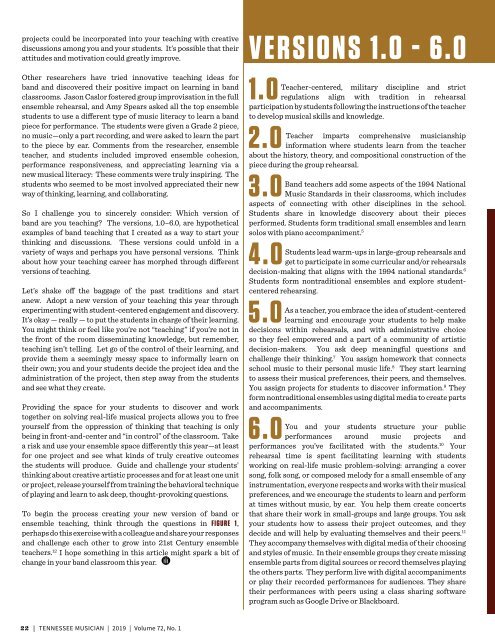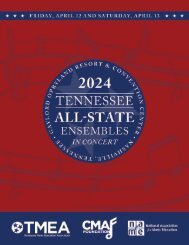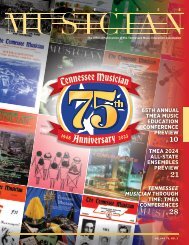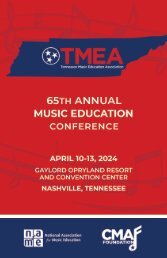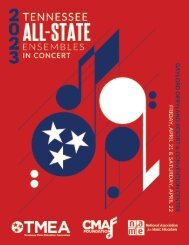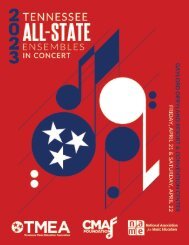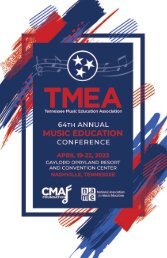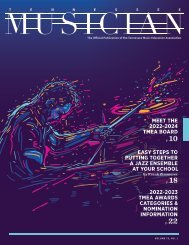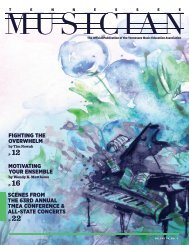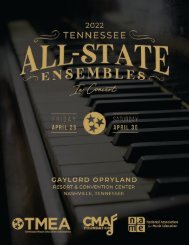You also want an ePaper? Increase the reach of your titles
YUMPU automatically turns print PDFs into web optimized ePapers that Google loves.
projects could be incorporated into your teaching with creative<br />
discussions among you and your students. It’s possible that their<br />
attitudes and motivation could greatly improve.<br />
Other researchers have tried innovative teaching ideas for<br />
band and discovered their positive impact on learning in band<br />
classrooms. Jason Caslor fostered group improvisation in the full<br />
ensemble rehearsal, and Amy Spears asked all the top ensemble<br />
students to use a different type of music literacy to learn a band<br />
piece for performance. The students were given a Grade 2 piece,<br />
no music—only a part recording, and were asked to learn the part<br />
to the piece by ear. Comments from the researcher, ensemble<br />
teacher, and students included improved ensemble cohesion,<br />
performance responsiveness, and appreciating learning via a<br />
new musical literacy: These comments were truly inspiring. The<br />
students who seemed to be most involved appreciated their new<br />
way of thinking, learning, and collaborating.<br />
So I challenge you to sincerely consider: Which version of<br />
band are you teaching? The versions, 1.0–6.0, are hypothetical<br />
examples of band teaching that I created as a way to start your<br />
thinking and discussions. These versions could unfold in a<br />
variety of ways and perhaps you have personal versions. Think<br />
about how your teaching career has morphed through different<br />
versions of teaching.<br />
Let’s shake off the baggage of the past traditions and start<br />
anew. Adopt a new version of your teaching this year through<br />
experimenting with student-centered engagement and discovery.<br />
It’s okay — really — to put the students in charge of their learning.<br />
You might think or feel like you’re not “teaching” if you’re not in<br />
the front of the room disseminating knowledge, but remember,<br />
teaching isn’t telling. Let go of the control of their learning, and<br />
provide them a seemingly messy space to informally learn on<br />
their own; you and your students decide the project idea and the<br />
administration of the project, then step away from the students<br />
and see what they create.<br />
Providing the space for your students to discover and work<br />
together on solving real-life musical projects allows you to free<br />
yourself from the oppression of thinking that teaching is only<br />
being in front-and-center and “in control” of the classroom. Take<br />
a risk and use your ensemble space differently this year—at least<br />
for one project and see what kinds of truly creative outcomes<br />
the students will produce. Guide and challenge your students’<br />
thinking about creative artistic processes and for at least one unit<br />
or project, release yourself from training the behavioral technique<br />
of playing and learn to ask deep, thought-provoking questions.<br />
To begin the process creating your new version of band or<br />
ensemble teaching, think through the questions in FIGURE 1,<br />
perhaps do this exercise with a colleague and share your responses<br />
and challenge each other to grow into 21st Century ensemble<br />
teachers. 12 I hope something in this article might spark a bit of<br />
change in your band classroom this year.<br />
VERSIONS 1.0 - 6.0<br />
1.0<br />
Teacher-centered, military discipline and strict<br />
regulations align with tradition in rehearsal<br />
participation by students following the instructions of the teacher<br />
to develop musical skills and knowledge.<br />
2.0<br />
Teacher imparts comprehensive musicianship<br />
information where students learn from the teacher<br />
about the history, theory, and compositional construction of the<br />
piece during the group rehearsal.<br />
3.0<br />
Band teachers add some aspects of the 1994 National<br />
Music Standards in their classrooms, which includes<br />
aspects of connecting with other disciplines in the school.<br />
Students share in knowledge discovery about their pieces<br />
performed. Students form traditional small ensembles and learn<br />
solos with piano accompaniment. 5<br />
4.0<br />
Students lead warm-ups in large-group rehearsals and<br />
get to participate in some curricular and/or rehearsals<br />
decision-making that aligns with the 1994 national standards. 6<br />
Students form nontraditional ensembles and explore studentcentered<br />
rehearsing.<br />
5.0<br />
As a teacher, you embrace the idea of student-centered<br />
learning and encourage your students to help make<br />
decisions within rehearsals, and with administrative choice<br />
so they feel empowered and a part of a community of artistic<br />
decision-makers. You ask deep meaningful questions and<br />
challenge their thinking. 7 You assign homework that connects<br />
school music to their personal music life. 8 They start learning<br />
to assess their musical preferences, their peers, and themselves.<br />
You assign projects for students to discover information. 9 They<br />
form nontraditional ensembles using digital media to create parts<br />
and accompaniments.<br />
6.0<br />
You and your students structure your public<br />
performances around music projects and<br />
performances you’ve facilitated with the students. 10 Your<br />
rehearsal time is spent facilitating learning with students<br />
working on real-life music problem-solving: arranging a cover<br />
song, folk song, or composed melody for a small ensemble of any<br />
instrumentation, everyone respects and works with their musical<br />
preferences, and we encourage the students to learn and perform<br />
at times without music, by ear. You help them create concerts<br />
that share their work in small-groups and large groups. You ask<br />
your students how to assess their project outcomes, and they<br />
decide and will help by evaluating themselves and their peers. 11<br />
They accompany themselves with digital media of their choosing<br />
and styles of music. In their ensemble groups they create missing<br />
ensemble parts from digital sources or record themselves playing<br />
the others parts. They perform live with digital accompaniments<br />
or play their recorded performances for audiences. They share<br />
their performances with peers using a class sharing software<br />
program such as Google Drive or Blackboard.<br />
22 | TENNESSEE MUSICIAN | 2019 | <strong>Vol</strong>ume <strong>72</strong>, <strong>No</strong>. 1


